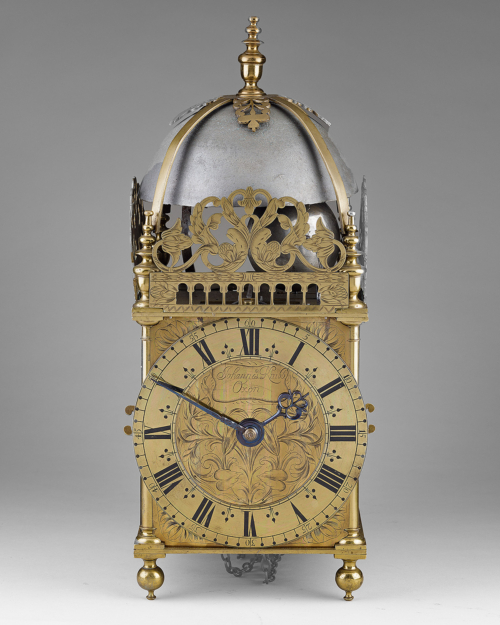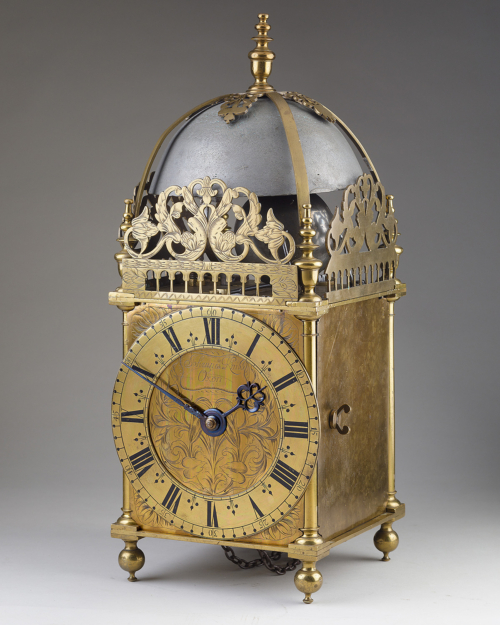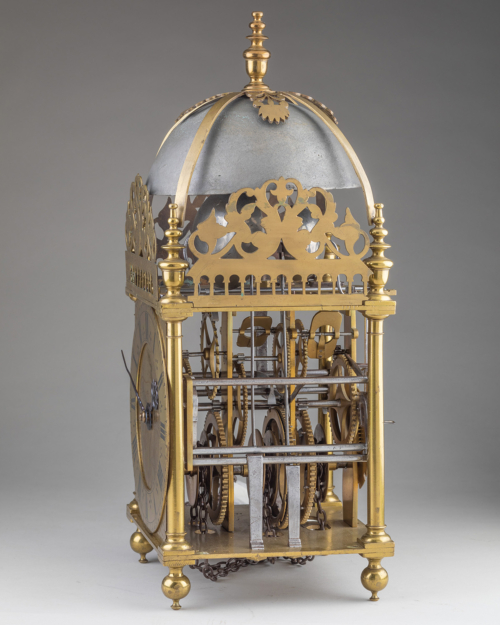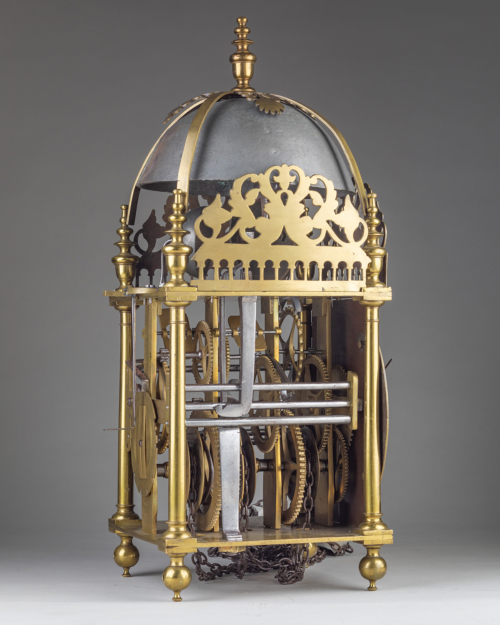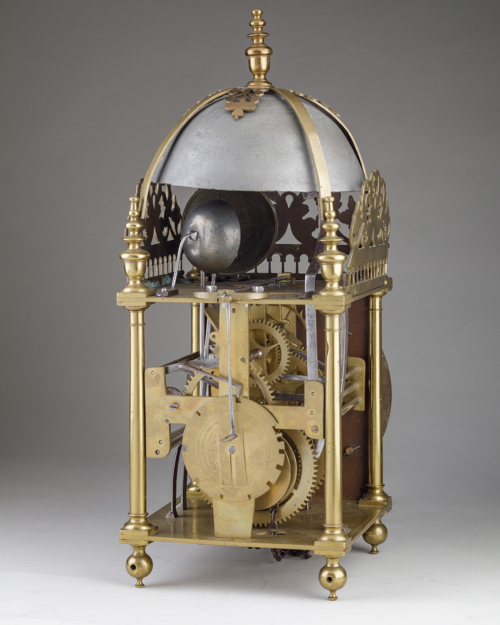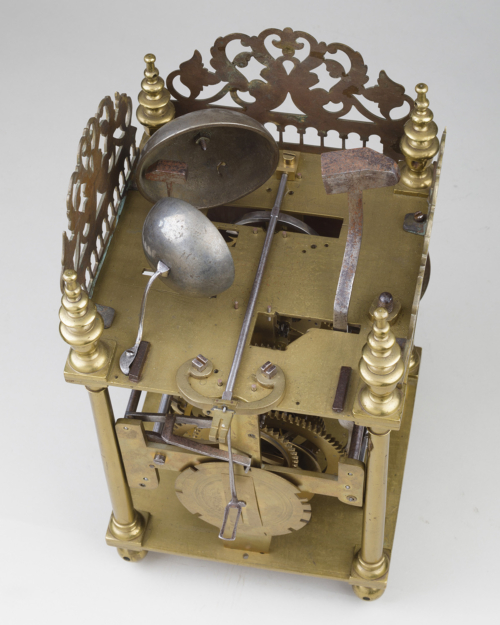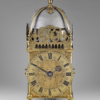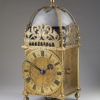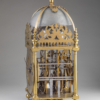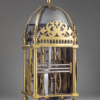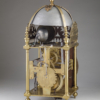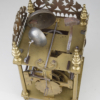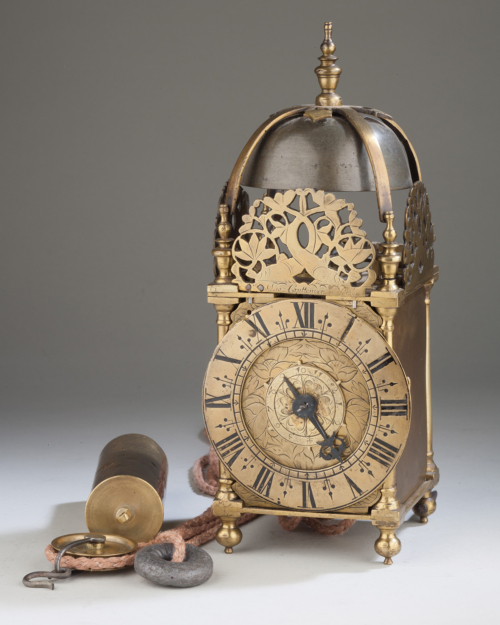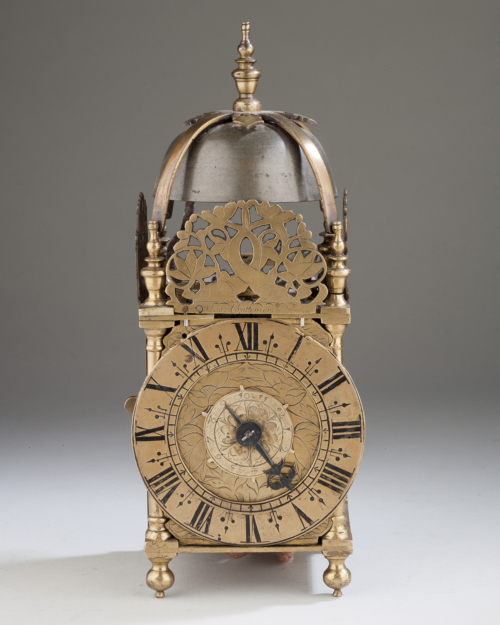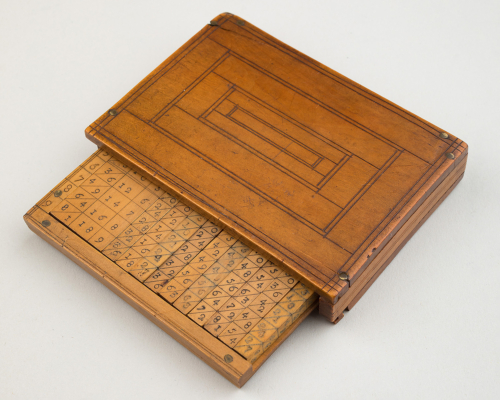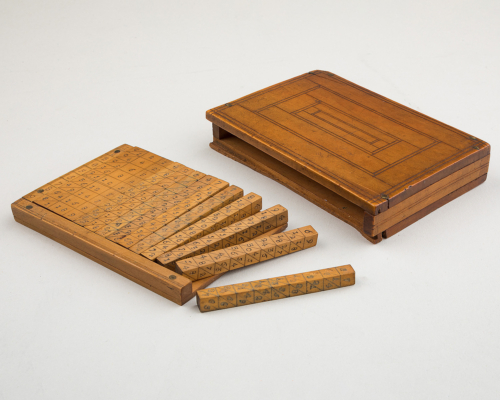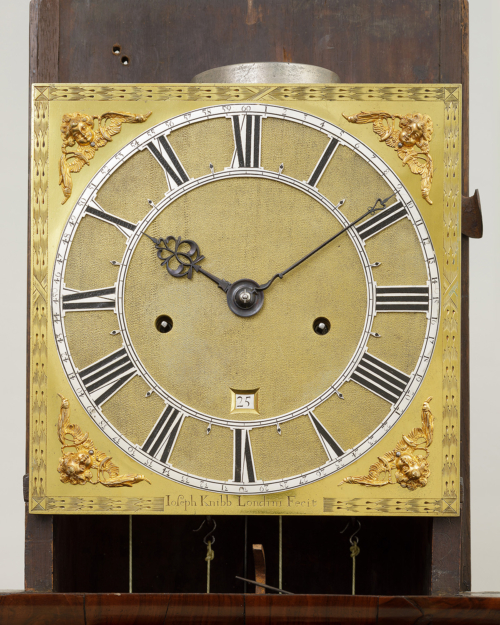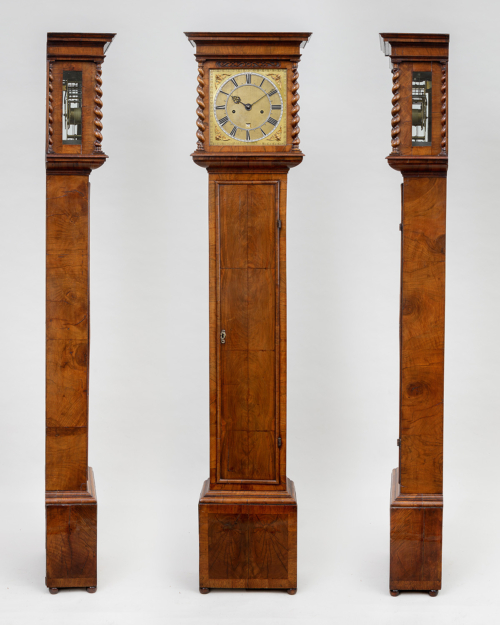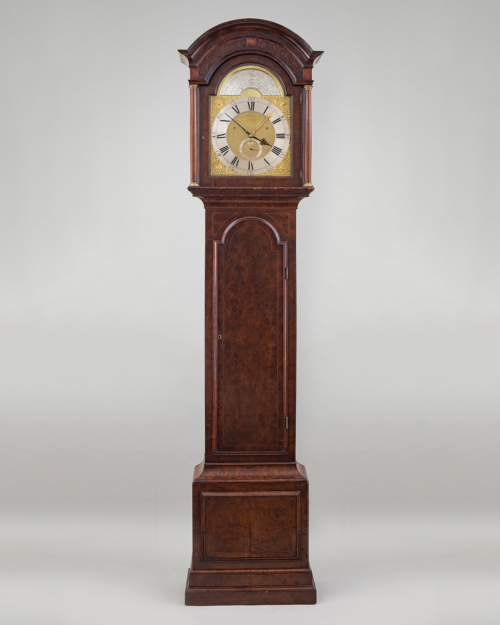| Height | 17¼ inches (440 mm) |
| Case | The case of standard lantern construction; circular section columns, ball feet and distinctive urn finials holding the top and bottom plates, with detachable slot-hinged side doors. The original floral gallery frets above, the front highlight engraved, the matching side frets left plain. The fancy bell-strap pinned to each pillar urn and the large bell held by a conforming urn top finial, the top plate with remnants of two separate riveted iron suspension eyes, and vacant holes in the rear ball feet for iron spurs. Now hung on a later walnut bracket. |
| Dial | The brass dial plate beautifully engraved with tulips and scrolling foliage, signed in a reserve below XII, Johannes Knibb Oxon, and enclosed by a 7 inch (178 mm) typical-Knibb brass Roman chapter ring, with fleur-de-lys half-hour marks and Arabic minutes every five within the individually dot-marked division ring, with finely pierced and shaped blued steel, Oxford-pattern, Knibb hands. |
| Movement | The movement, held by four vertical internal plates, the front and back of cruciform shape; the front going train driving the hour and minute hands, with an early conversion to anchor escapement, the pallets pivoted on a Knibb-style butterfly shaped backcock, with suspension for the long pendulum; the middle quarter train uses a countwheel and double sided pinwheel to ting-tang quarter strike on the two smaller bells mounted to the top-plate; the rear hour train governed by a countwheel mounted on the rear plate and striking on the large bell above; all three trains are chain driven. |
| Duration | 30 hour |
| Provenance | The Justice Shepro Collection, USA, until sold; |
| Literature | George White, English Lantern Clocks, 1989, (illus.) p.260; |
| Escapement | Early conversion to anchor with long pendulum |
| Strike Type | Countwheel full quarter strike (including 4 ting-tangs with the hour) |
Exhibit № 21. John Knibb, Oxford, Circa 1675-80
An important and rare Charles II brass two-handed three-train full quarter striking lantern clock
Sold
Complex lantern clocks by the best makers are rare and this Oxford clock by John Knibb was most likely a special commission. It is a superb example of this traditional form of wall clock, but with the rare addition of a third train giving full ting-tang quarter striking on two bells, including four quarters preceding each hour. It is presented in the Knibb family’s own inimitable style, including their pattern of larger-size frame with the top-plate retaining evidence of their preference for individual suspension eyes, rather than a hoop; a typical Knibb chapter ring with additional dot-marked minutes; beautifully executed ‘Oxford-pattern’ hands; and the dial plate has archetypal tulip engraving to the centre below the signature reserve.
John Knibb, Oxford (1650-1722)
John was the sixth son of Thomas Knibb, yeoman of Claydon and Elizabeth (nee Wise) his wife, born 21st January 1650. In about 1664, he joined and trained with his elder brother, Joseph, as apprentice or assistant, and lived with him first in St. Clement’s and later in Holywell Street, Oxford.
John and his wife, also Elizabeth, were lifelong parishioners of St. Cross Church, Holywell, where they were buried, and where all of their children were baptised. They had three sons and five daughters between 1679 and 1695. However, three of the daughters died young and a fourth, Mary, died aged 22, while their eldest child, Elizabeth, and three sons, John junior, George and Joseph all survived John.
In 1671 his brother Joseph Knibb was admitted to London’s Clockmakers’ Company as a brother. He may frequently have returned to Oxford but the main responsibility for the business must have rested with young John, by then aged 20. It was not until 13th September 1672 that John applied for the city freedom and although he technically he had none of the required qualifications, the Council agreed to admit him on the 27th September on payment of a £30 fine. John considered this excessive and on 22nd March 1673 the Council …at the earnest request of B. Whorwood, Esq., and out of respect for him… reduced the fee from £30 to 20 marks and he was freed on 11th April following.
Beeson suggests he was not entitled to sign his goods before 1673, and that the clocks from the Holywell shop would have been signed for Joseph until as late as the end of 1672. It is also likely that clocks were passing between the two workshops from the time of Joseph’s move to London (see jointly signed Phase III timepiece, exhibit no.31, p.140). Over his career John Knibb took the following apprentices: Samuel Aldworth; William Hitchcock; Thomas Lidbrook (a cousin), Mathias Unite, John Ford, John Goweth, John Free, Thomas Gillett, George Wentworth and Humphrey Brickland.
John continued in the sub-tenanted university property at the 27th house in Holywell Street that he had occupied with his brother, but sometime between 1682 and 1692 he moved to another sub-tenancy in the 26th house adjacent. In 1696 John was paying window tax on 14 windows in Hollowell, and by September 1697 the city subleased to him two tenements also part of the 26th house for 31 years with an option for renewal. These large premises provided a frontage to the highway of 102 feet and a depth of 40 to 61 feet.
John’s civic ambitions began in September 1686 when he was appointed one of the twenty-four members of the council. In October 1688 he was elected bailiff, an event noted by the antiquary Anthony Wood in his diaries and papers of 1623-1695: 2 Oct. 1688, …for the election of new officers: the house and commons then chose Robert Harrison, mayor… Richard Lumley and John Knibb, bailives. On 11th April 1689 John and six others went in attendance on Robert Harrison, Mayor of Oxford, at the coronation of William and Mary at Westminster. In 1690 he made the turret clock for St John’s College and was elected bailiff again from 1690 to 1696. On 16th November 1693, Anthony Wood recorded in his diary, Borrowed a brass watch of Mr Knibb. On 11th October 1697 John was elected one of the eight Assistants to the Mayor, and a year later, on 19th November 1698, started his first term as Mayor. In 1700 he was Keykeeper and assistant member of the Mayor’s Council and as Keykeeper thereafter he continued to be active in civic affairs. In September 1710 John was re-elected for a second term as Mayor and in 1716 he was chosen Alderman.
The antiquary Thomas Hearne was an acquaintance and in November 1716 he wrote, somewhat disparagingly, This Nibb is a man of so little understanding that he was never known to laugh.
John Knibb died on 18th July 1722 and the following day Hearne recorded, Last night, about 8 Clock, died suddenly Mr. Alderman Knibb of Oxford, an old, quiet, harmless Man abt. 4 score years of Age. He lived by Smith Gate in Holywell Parish. ‘Tis said he eat his supper heartily, went round New Parks with his Wife sate himself down in his chair and died. A few days since I talked with him about Antiquities, when he told me he hath seen Anslap Spire in Bucks from Brill he having, it seems, some Estate or Fortune at Anslapp [Hanslope].
John was buried four days later at St. Cross Church, Holywell. Some years later a memorial stone to the family was placed on the north wall of the aisle and this incorrectly recorded his date of death as the 22nd. In his will John left all his personal and leasehold estate to his wife except one tenancy that went to John junior for which an annuity was to be paid to his mother. John stated that the reason no other provision was made for his children was that their uncle Joseph had amply provided for them. Joseph’s substantial estate, mentioned above by Hearne, had been held by John in trust for his own eldest son John. Annuities were payable by him and then by John junior to Joseph’s wife, Elizabeth, until she died on 5th December 1726.
Product Description
Complex lantern clocks by the best makers are rare and this Oxford clock by John Knibb was most likely a special commission. It is a superb example of this traditional form of wall clock, but with the rare addition of a third train giving full ting-tang quarter striking on two bells, including four quarters preceding each hour. It is presented in the Knibb family’s own inimitable style, including their pattern of larger-size frame with the top-plate retaining evidence of their preference for individual suspension eyes, rather than a hoop; a typical Knibb chapter ring with additional dot-marked minutes; beautifully executed ‘Oxford-pattern’ hands; and the dial plate has archetypal tulip engraving to the centre below the signature reserve.
John Knibb, Oxford (1650-1722)
John was the sixth son of Thomas Knibb, yeoman of Claydon and Elizabeth (nee Wise) his wife, born 21st January 1650. In about 1664, he joined and trained with his elder brother, Joseph, as apprentice or assistant, and lived with him first in St. Clement’s and later in Holywell Street, Oxford.
John and his wife, also Elizabeth, were lifelong parishioners of St. Cross Church, Holywell, where they were buried, and where all of their children were baptised. They had three sons and five daughters between 1679 and 1695. However, three of the daughters died young and a fourth, Mary, died aged 22, while their eldest child, Elizabeth, and three sons, John junior, George and Joseph all survived John.
In 1671 his brother Joseph Knibb was admitted to London’s Clockmakers’ Company as a brother. He may frequently have returned to Oxford but the main responsibility for the business must have rested with young John, by then aged 20. It was not until 13th September 1672 that John applied for the city freedom and although he technically he had none of the required qualifications, the Council agreed to admit him on the 27th September on payment of a £30 fine. John considered this excessive and on 22nd March 1673 the Council …at the earnest request of B. Whorwood, Esq., and out of respect for him… reduced the fee from £30 to 20 marks and he was freed on 11th April following.
Beeson suggests he was not entitled to sign his goods before 1673, and that the clocks from the Holywell shop would have been signed for Joseph until as late as the end of 1672. It is also likely that clocks were passing between the two workshops from the time of Joseph’s move to London (see jointly signed Phase III timepiece, exhibit no.31, p.140). Over his career John Knibb took the following apprentices: Samuel Aldworth; William Hitchcock; Thomas Lidbrook (a cousin), Mathias Unite, John Ford, John Goweth, John Free, Thomas Gillett, George Wentworth and Humphrey Brickland.
John continued in the sub-tenanted university property at the 27th house in Holywell Street that he had occupied with his brother, but sometime between 1682 and 1692 he moved to another sub-tenancy in the 26th house adjacent. In 1696 John was paying window tax on 14 windows in Hollowell, and by September 1697 the city subleased to him two tenements also part of the 26th house for 31 years with an option for renewal. These large premises provided a frontage to the highway of 102 feet and a depth of 40 to 61 feet.
John’s civic ambitions began in September 1686 when he was appointed one of the twenty-four members of the council. In October 1688 he was elected bailiff, an event noted by the antiquary Anthony Wood in his diaries and papers of 1623-1695: 2 Oct. 1688, …for the election of new officers: the house and commons then chose Robert Harrison, mayor… Richard Lumley and John Knibb, bailives. On 11th April 1689 John and six others went in attendance on Robert Harrison, Mayor of Oxford, at the coronation of William and Mary at Westminster. In 1690 he made the turret clock for St John’s College and was elected bailiff again from 1690 to 1696. On 16th November 1693, Anthony Wood recorded in his diary, Borrowed a brass watch of Mr Knibb. On 11th October 1697 John was elected one of the eight Assistants to the Mayor, and a year later, on 19th November 1698, started his first term as Mayor. In 1700 he was Keykeeper and assistant member of the Mayor’s Council and as Keykeeper thereafter he continued to be active in civic affairs. In September 1710 John was re-elected for a second term as Mayor and in 1716 he was chosen Alderman.
The antiquary Thomas Hearne was an acquaintance and in November 1716 he wrote, somewhat disparagingly, This Nibb is a man of so little understanding that he was never known to laugh.
John Knibb died on 18th July 1722 and the following day Hearne recorded, Last night, about 8 Clock, died suddenly Mr. Alderman Knibb of Oxford, an old, quiet, harmless Man abt. 4 score years of Age. He lived by Smith Gate in Holywell Parish. ‘Tis said he eat his supper heartily, went round New Parks with his Wife sate himself down in his chair and died. A few days since I talked with him about Antiquities, when he told me he hath seen Anslap Spire in Bucks from Brill he having, it seems, some Estate or Fortune at Anslapp [Hanslope].
John was buried four days later at St. Cross Church, Holywell. Some years later a memorial stone to the family was placed on the north wall of the aisle and this incorrectly recorded his date of death as the 22nd. In his will John left all his personal and leasehold estate to his wife except one tenancy that went to John junior for which an annuity was to be paid to his mother. John stated that the reason no other provision was made for his children was that their uncle Joseph had amply provided for them. Joseph’s substantial estate, mentioned above by Hearne, had been held by John in trust for his own eldest son John. Annuities were payable by him and then by John junior to Joseph’s wife, Elizabeth, until she died on 5th December 1726.
Additional information
| Dimensions | 5827373 cm |
|---|

